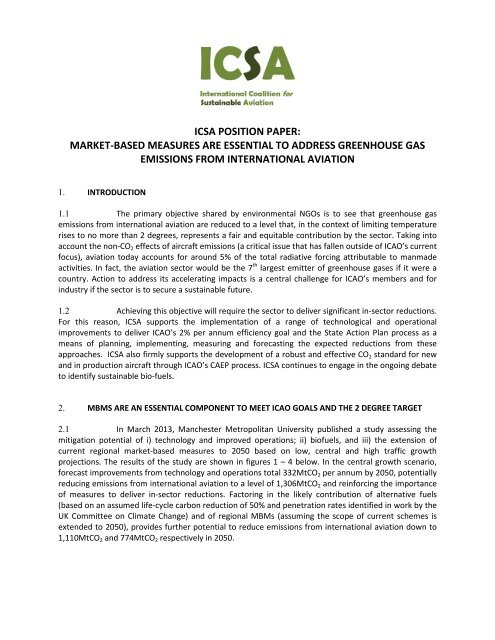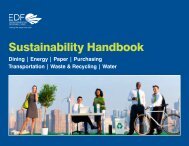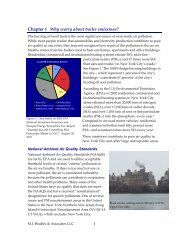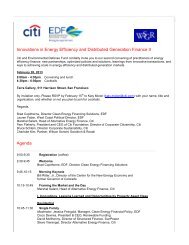icsa position paper - Transport & Environment
icsa position paper - Transport & Environment
icsa position paper - Transport & Environment
You also want an ePaper? Increase the reach of your titles
YUMPU automatically turns print PDFs into web optimized ePapers that Google loves.
ICSA POSITION PAPER:<br />
MARKET-BASED MEASURES ARE ESSENTIAL TO ADDRESS GREENHOUSE GAS<br />
EMISSIONS FROM INTERNATIONAL AVIATION<br />
1. INTRODUCTION<br />
1.1 The primary objective shared by environmental NGOs is to see that greenhouse gas<br />
emissions from international aviation are reduced to a level that, in the context of limiting temperature<br />
rises to no more than 2 degrees, represents a fair and equitable contribution by the sector. Taking into<br />
account the non-CO 2 effects of aircraft emissions (a critical issue that has fallen outside of ICAO’s current<br />
focus), aviation today accounts for around 5% of the total radiative forcing attributable to manmade<br />
activities. In fact, the aviation sector would be the 7 th largest emitter of greenhouse gases if it were a<br />
country. Action to address its accelerating impacts is a central challenge for ICAO’s members and for<br />
industry if the sector is to secure a sustainable future.<br />
1.2 Achieving this objective will require the sector to deliver significant in-sector reductions.<br />
For this reason, ICSA supports the implementation of a range of technological and operational<br />
improvements to deliver ICAO’s 2% per annum efficiency goal and the State Action Plan process as a<br />
means of planning, implementing, measuring and forecasting the expected reductions from these<br />
approaches. ICSA also firmly supports the development of a robust and effective CO 2 standard for new<br />
and in production aircraft through ICAO’s CAEP process. ICSA continues to engage in the ongoing debate<br />
to identify sustainable bio-fuels.<br />
2. MBMS ARE AN ESSENTIAL COMPONENT TO MEET ICAO GOALS AND THE 2 DEGREE TARGET<br />
2.1 In March 2013, Manchester Metropolitan University published a study assessing the<br />
mitigation potential of i) technology and improved operations; ii) biofuels, and iii) the extension of<br />
current regional market-based measures to 2050 based on low, central and high traffic growth<br />
projections. The results of the study are shown in figures 1 – 4 below. In the central growth scenario,<br />
forecast improvements from technology and operations total 332MtCO 2 per annum by 2050, potentially<br />
reducing emissions from international aviation to a level of 1,306MtCO 2 and reinforcing the importance<br />
of measures to deliver in-sector reductions. Factoring in the likely contribution of alternative fuels<br />
(based on an assumed life-cycle carbon reduction of 50% and penetration rates identified in work by the<br />
UK Committee on Climate Change) and of regional MBMs (assuming the scope of current schemes is<br />
extended to 2050), provides further potential to reduce emissions from international aviation down to<br />
1,110MtCO 2 and 774MtCO 2 respectively in 2050.
- 2 -<br />
Figure 1 – Forecast technological and operational<br />
Figure 2 – Forecast emission reduction from technology,<br />
improvements (source: MMU, 2013) operations and biofuels (source: MMU, 2013)<br />
Figure 3 – Forecast emission reduction units from technology<br />
Figure 4 - Growth and reduction scenarios measured<br />
and operations, biofuels and regional MBMs extended out to<br />
against 2020, 2005, and 2005-10% goals (source:<br />
2050 (source: MMU, 2013) MMU, 2013)<br />
2.2 The report identified that none of the measures, or their combinations, for any growth<br />
scenario would achieve ICAO’s aspirational 2020 carbon-neutral goal by 2050, the 2005 stabilization of<br />
emissions goal, or the 2005-10% stabilization of emissions goal. The 2% per annum efficiency goal would<br />
only just be met in 2050 by assuming maximum reductions from technology, operations, and a<br />
“speculative” availability of bio-fuels. The resulting “emissions gap” in 2050 was put at between<br />
153MtCO 2 and 387MtCO 2 (or approximately 15-38% of the total emissions reduction effort required to<br />
achieve a no net increase in emissions from international aviation from 2020). A global MBM is the only<br />
feasible mechanism to close this gap, and should therefore be incorporated now as an essential<br />
component of ICAO’s approach. Against ICAO’s aspirational goal, the gap already appears shortly after<br />
2020 (in the absence of the EU ETS), highlighting the urgent need for early action. The industry’s own<br />
CO 2 roadmap to 2050 also highlights the need for MBMs in the short- to medium-term (with a global<br />
MBM preferred by airlines and their trade associations, as well as trade and tourism organisations, when<br />
compared to the administrative burden and cost of complying with a patchwork of national or regional<br />
carbon pricing systems).
- 3 -<br />
3. MARKET-BASED MEASURES<br />
3.1 Viewed from the perspective of environmental protection, MBMs provide certainty that<br />
environmental targets will be met. In the context of ICAO, this approach can ensure effective and<br />
efficient delivery of the 2020 aspirational goal, and, in response to Assembly Resolution A37-19 that<br />
requested further work on the attainability and other issues associated with longer-term goals, provides<br />
the confidence to set binding, ambitious medium- and long-term goals. There is also a strong economic<br />
rationale for using MBMs. There are practical limits to how aggressively technology improvements or<br />
accelerated fleet replacement can be pursued, and overly ambitious fuel efficiency goals could lead to<br />
high abatement costs per tonne of CO 2 reduced relative to other sectors (which would negatively impact<br />
costs and thus growth). Access to the carbon markets therefore provides a more cost-effective means of<br />
bridging the gap between in-sector reductions and ICAO’s own environmental objectives for the sector,<br />
while introducing a carbon price that will further encourage airlines to speed up deployment of<br />
technical, operational and alternative fuel measures.<br />
3.2 <strong>Environment</strong>al integrity must be a central priority in this regard. The quality of emission<br />
reduction units available to aviation is a key design issue affecting the environmental integrity of a<br />
MBM, and demonstrating measurement, transparency, additionality and permanence will be essential.<br />
At the same time, the carbon markets are expanding within States and at national levels, and there is no<br />
reason to assume that a healthy market will not exist in the future, sufficient to meet both aviation’s<br />
needs and robust sustainability criteria.<br />
4. PREFERENCE FOR A GLOBAL MBM<br />
4.1 ICSA continues to press the need for the early introduction of a global MBM for<br />
international aviation, and it should be agreed at the 38 th Assembly, along with a decision on the key<br />
design criteria where there is common ground and a timeline to finalise any outstanding<br />
implementation details next year.<br />
4.2 A MBM should be viewed as a necessary and complementary measure to other<br />
approaches in the ICAO basket and should be designed in such a way that it incentivises, rather than<br />
distracts from, in-sector reductions. ICSA also believes that a global MBM must be fair and avoid any<br />
competitive distortions (through equal treatment of all carriers operating on a given route), and that it<br />
can, and should, reflect the special circumstances and respective capabilities of developing countries<br />
(SCRCDC). This recognises that a MBM must be flexible enough to address not only overall growth in the<br />
sector, but differential growth rates in regions and differential growth rates over time. As well as the<br />
practical options identified in the MBM Expert Group to accommodate these concerns, ICSA suggests<br />
there is further merit in considering route-based allocation tools (differentiation between routes rather<br />
than between States or nationality of carrier), using the diversity of offset sources available to explore<br />
synergies with related sectors (e.g. travel and tourism), and fostering broad participation through<br />
program design options that maintain environmental integrity while supporting sovereign choices about<br />
domestic implementation.<br />
4.3 ICSA continues to contribute to the development of the three options through the MBM<br />
expert group working alongside the Secretariat and commends its continuation. This work, as presented<br />
to the Council at its November 2012 session, showed that all options under consideration are technically<br />
feasible.
- 4 -<br />
5. A FRAMEWORK FOR MBMS<br />
5.1 ICSA reiterates the urgency for ICAO to agree and implement a global MBM but,<br />
recalling that Assembly Resolution A37-19 recognised that some States may take more ambitious<br />
actions prior to 2020, believes that national and regional MBMs are important tools both in the interim<br />
period until 2020 or beyond in the absence of a global MBM. The alternative scenario, namely no action<br />
at a State level in the absence of a global MBM taking effect, cannot be supported.<br />
5.2 To create legal and political certainty for States wishing to take action, and to promote<br />
harmonised actions that encourage linkages and minimise administrative burdens, ICSA stresses the<br />
imperative of agreeing a realistic and workable framework for MBMs at the 38 th Assembly. Such a<br />
framework must be capable of scaling to cover 100% of international aviation emissions, without any<br />
duplication of effort. Of the approaches identified to date, only the “all departing flights”, “nationality of<br />
carrier” and “FIR airspace” approaches are capable of achieving this objective: a recent study has shown<br />
that confining the geographical scope of actions to the proportion of departing or arriving flights that<br />
take place in sovereign airspace only can produce a maximum coverage of 22% of emissions:<br />
Location of international aviation emissions (2006) Distribution of international aviation emissions<br />
Emissions occurring in the sovereign airspace of states<br />
22%<br />
for departing and arriving flights only<br />
Emissions from over flights above sovereign airspace of<br />
33%<br />
a State that is neither the State of departure or arrival<br />
Emissions in international airspace (over water) 44%<br />
Total emissions 100%<br />
Source: Manchester Metropolitan University, 2013<br />
5.3 Coupled with its associated administrative complexity, a sovereign airspace approach is<br />
not considered to be feasible. Of the remaining approaches, the nationality of carrier (while potentially<br />
suited to a global MBM solely in the context of minimising administrative burden on participants) has, in<br />
the context of national and regional measures, the potential for unequal treatment of carriers operating<br />
on the same route, while an FIR airspace approach also suffers from administrative complexity. For<br />
these reasons, ICSA supports all departing flights from a State as the only appropriate and practical<br />
approach to geographical scope. Furthermore, it is consistent with State reporting of emissions from<br />
international aviation to the UNFCCC (with a supporting IPCC methodology).<br />
6. THE NEED TO ACHIEVE PROGRESS IN 2013<br />
6.1 Addressing the climate challenge is a common goal of all States and sectors and can only<br />
be realised through co-ordinated action. Achieving the objective of stabilising atmospheric<br />
concentrations of greenhouse gas emissions at a level that limits temperature rises to no more than 2<br />
degrees Celsius above preindustrial levels depends not only on agreeing goals and measures, but on<br />
timely action. Aviation is predicting strong growth out to 2050, and the public visibility of the associated<br />
increase in greenhouse gas emissions makes an agreement now in ICAO essential. While opposing<br />
political perspectives have prevented an ICAO agreement on MBMs over the past 15 years, ICSA believes<br />
that the development of a global MBM is capable of reconciling such differences in practical ways,<br />
noting that MBMs are cost-effective, technically feasible and will have only marginal impacts on the<br />
future growth projections of the industry even with the generation of revenues (which warrant serious
- 5 -<br />
consideration, both as a step towards full carbon pricing and as a potential means to address special<br />
circumstances and respective capabilities).<br />
6.2 ICSA is developing many of the ideas in this <strong>paper</strong> and, as the recognised observer<br />
organisation representing the environmental NGO community at ICAO, wishes to contribute fully to the<br />
HGCC, Council and Assembly decision-making, requesting ICAO to embrace the benefits of positive and<br />
transparent engagement with civil society at all levels of the debate.<br />
ICSA, March 2013



![Annotated bibliography [PDF] - Environmental Defense Fund](https://img.yumpu.com/50613332/1/190x245/annotated-bibliography-pdf-environmental-defense-fund.jpg?quality=85)

![What do we mean by MSY? [PDF]](https://img.yumpu.com/49525661/1/190x245/what-do-we-mean-by-msy-pdf.jpg?quality=85)

![Print version [PDF] - Environmental Defense Fund](https://img.yumpu.com/46812189/1/190x201/print-version-pdf-environmental-defense-fund.jpg?quality=85)
![Mercury Alert: Cleaning up Coal Plants for Healthier Lives [PDF]](https://img.yumpu.com/45587786/1/190x143/mercury-alert-cleaning-up-coal-plants-for-healthier-lives-pdf.jpg?quality=85)

![Program Overview [PDF] - Environmental Defense Fund](https://img.yumpu.com/34005758/1/190x96/program-overview-pdf-environmental-defense-fund.jpg?quality=85)


